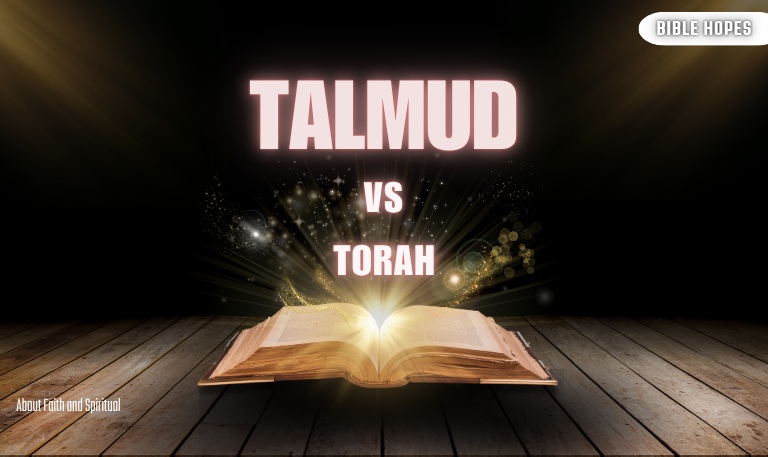When exploring Jewish sacred texts, two terms frequently arise — Torah and Talmud. Many people confuse these foundational works or assume they are interchangeable. However, understanding the difference between the Talmud vs Torah is essential for grasping Jewish theology, law, and tradition.
The Torah is the bedrock of Jewish scripture, while the Talmud is a vast body of commentary and rabbinic discussion that interprets and expands upon the Torah’s laws and narratives. This article delves deeply into what each text represents, their origins, structures, functions, and the nuanced interplay between them in Jewish life and law.
1. Defining the Torah: The Written Foundation of Judaism
What Is the Torah?
The Torah refers primarily to the Five Books of Moses, also known as the Pentateuch. These books — Genesis, Exodus, Leviticus, Numbers, and Deuteronomy — are considered divine revelation and form the written law in Judaism.
The Torah is revered as the blueprint of Jewish faith and practice, containing narratives of creation, patriarchs, exodus from Egypt, and a detailed legal code.
Key Features of the Torah
Divine origin: Traditionally believed to be dictated by God to Moses on Mount Sinai.
Written in Biblical Hebrew: The Torah is primarily in Hebrew, with a formal and poetic style.
Core laws and commandments: It contains the 613 mitzvot (commandments) that govern Jewish life.
Central to Jewish worship: Torah scrolls are read publicly in synagogues weekly.
Read Also: Atheism Vs Theism
2. Defining the Talmud: The Oral Tradition Codified
What Is the Talmud?
The Talmud is a comprehensive collection of rabbinic discussions that analyze, interpret, and expand upon the Torah’s laws and teachings. It serves as the authoritative source of Jewish Oral Law, traditionally passed down orally until it was compiled in written form.
The Talmud consists of two main parts:
Mishnah: The earliest compilation of oral laws, completed around 200 CE.
Gemara: Rabbinic commentary and debate on the Mishnah, completed around 500 CE.
Types of Talmud
Babylonian Talmud (Talmud Bavli): More comprehensive and widely studied.
Jerusalem Talmud (Talmud Yerushalmi): Earlier and shorter, compiled in the Land of Israel.
3. Historical Origins and Timeline
| Text | Period of Composition | Nature |
|---|---|---|
| Torah | Traditionally ~1300 BCE | Written law, divine revelation |
| Mishnah | ~200 CE | Oral law codified |
| Gemara | ~500 CE | Rabbinic commentary |
| Talmud | Mishnah + Gemara compiled | Oral law written and discussed |
The Torah predates the Talmud by over a millennium. The Talmud was developed to clarify and apply Torah laws in evolving historical contexts.
4. Structure and Content: Torah vs Talmud
Torah Structure
Narrative sections (stories, history)
Legal codes (ritual, ethical, civil laws)
Prophetic and poetic elements
Talmud Structure
Mishnah: concise legal rulings
Gemara: dialectical debates, stories, ethics, and case law
Extensive multi-layered discussions — sometimes spanning dozens of pages per topic
5. Purpose and Function: Complementary Roles
| Aspect | Torah | Talmud |
|---|---|---|
| Purpose | Divine law and foundational narrative | Interpretation and application of Torah laws |
| Function | Provides commandments (mitzvot) and stories | Explains how to observe commandments in detail |
| Usage | Scripture for ritual reading | Study and legal decision-making tool |
The Torah sets the law; the Talmud explains how to follow it.
6. Language and Style Differences
Torah: Biblical Hebrew, formal, narrative and legal prose.
Talmud: Mixture of Hebrew and Aramaic, complex and dialectical style with back-and-forth debates.
7. Religious Authority and Usage in Jewish Life
Torah: Treasured as the sacred text read publicly and kept in the ark during synagogue services.
Talmud: Studied intensely by scholars and rabbis, forming the basis for Halacha (Jewish law).
The Torah is the unchanging word of God; the Talmud is the evolving discussion that keeps Jewish law alive and relevant.
8. Educational Approaches: How Are They Studied?
Torah: Introduced in childhood through simplified teachings and synagogue participation.
Talmud: Requires years of study, traditionally in yeshivot (Jewish academies), often in pairs or groups for debate.
9. Interpretations and Commentaries
Many commentaries exist for both texts, e.g., Rashi, Maimonides.
The Talmud embraces multiple viewpoints, reflecting diverse rabbinic opinions.
This plurality strengthens Jewish legal flexibility.
10. Influence on Jewish Law and Culture
Torah: Source of the 613 commandments, rituals, and ethics.
Talmud: Framework for practically implementing these commandments and resolving new legal questions.
11. Key Historical Figures
Moses: Receiver and transmitter of the Torah.
Rabbinic Sages: Compilers of the Mishnah and Gemara, shaping the Talmudic tradition.
12. Differences Across Jewish Movements
Orthodox Judaism: Emphasizes strict adherence to both Torah and Talmud.
Conservative Judaism: Respects both but may allow historical-critical study.
Reform Judaism: Often emphasizes ethical teachings of Torah, less focus on Talmudic law.
13. Common Misconceptions
The Talmud is not a replacement for the Torah; it’s complementary.
Torah is not just laws but includes rich narratives.
Talmud study is not exclusive to rabbis today; many engage with translations and study groups.
14. The Oral Torah and Written Torah: A Critical Distinction
Torah is the Written Law.
Talmud preserves the Oral Law — teachings Moses passed orally and rabbis developed further.
15. Comparison with Other Religious Texts
Torah = first five books of the Christian Old Testament, but differs in religious role.
Talmud has no equivalent in Christianity or Islam but parallels detailed religious legal codes.
16. Modern Applications and Accessibility
Digital editions of Torah and Talmud enable global study.
Talmud study has become more accessible with translations and online classes.
17. Controversies and Challenges
Historical debates about the Talmud’s authority.
Complexity of the Talmud can be a barrier to beginners.
Interfaith misunderstandings sometimes arise regarding Talmudic content.
Read Also: Is Karma Real
18. Summary Table: Talmud vs Torah
| Feature | Torah | Talmud |
|---|---|---|
| Type | Written scripture | Oral law codified and discussed |
| Content | Narrative, commandments | Rabbinic discussions, legal analysis |
| Language | Biblical Hebrew | Hebrew and Aramaic |
| Role | Foundation of Jewish law and faith | Interpretation and application |
| Usage | Public worship, ritual reading | Legal study, decision-making |
| Authority | Divine, immutable | Rabbinic, interpretative |
Talmud vs Torah FAQs
Q: Is the Talmud part of the Torah?
A: No. The Torah is the foundational written scripture, while the Talmud is a later compilation of rabbinic discussions about the Torah.
Q: Which is older, the Torah or the Talmud?
A: The Torah is much older, traditionally dated to Moses around 1300 BCE. The Talmud was compiled between 200–500 CE.
Q: Can anyone study the Talmud?
A: Yes. While traditionally studied by scholars, many modern translations and resources make it accessible to anyone interested.
Q: Why do some Jewish groups emphasize Torah over Talmud or vice versa?
A: Different denominations prioritize these texts based on theological outlooks — Orthodox Judaism values both equally, while Reform Judaism may focus more on Torah’s ethical teachings.
Q: How does the Talmud explain the commandments in the Torah?
A: The Talmud provides detailed interpretations, debates, and case law to clarify how Torah laws should be followed in various situations.
Q: What language is the Talmud written in?
A: Primarily Hebrew and Aramaic.
Q: Are there English translations of both texts?
A: Yes, many authoritative translations and commentaries are available for both Torah and Talmud.
Q: How do Torah and Talmud influence Jewish law today?
A: The Torah provides the original commandments; the Talmud shapes how these laws are applied, forming the basis of contemporary Jewish legal practice (Halacha).
Q: What is the difference between the Babylonian and Jerusalem Talmud?
A: The Babylonian Talmud is more extensive and widely studied; the Jerusalem Talmud is shorter and less commonly used.
Q: How do Torah and Talmud study differ today?
A: Torah study is more accessible to all ages; Talmud study often requires more advanced, analytical skills and is pursued in dedicated scholarly settings.
Conclusion
Understanding the distinction between the Torah and the Talmud is fundamental to appreciating the depth and richness of Jewish tradition. While the Torah stands as the sacred written foundation — the divine laws and stories given to Moses — the Talmud serves as the dynamic, interpretative dialogue that brings those laws to life, guiding generations in their application.



![15 Pink Bible Verses | Discover Meaning, Love [2025 Guide] 5 15-Pink-Bible-Verses-Discover-Meaning,-Love-[2025-Guide]](https://biblehopes.com/wp-content/uploads/2025/05/15-Pink-Bible-Verses-Discover-Meaning-Love-2025-Guide.png)